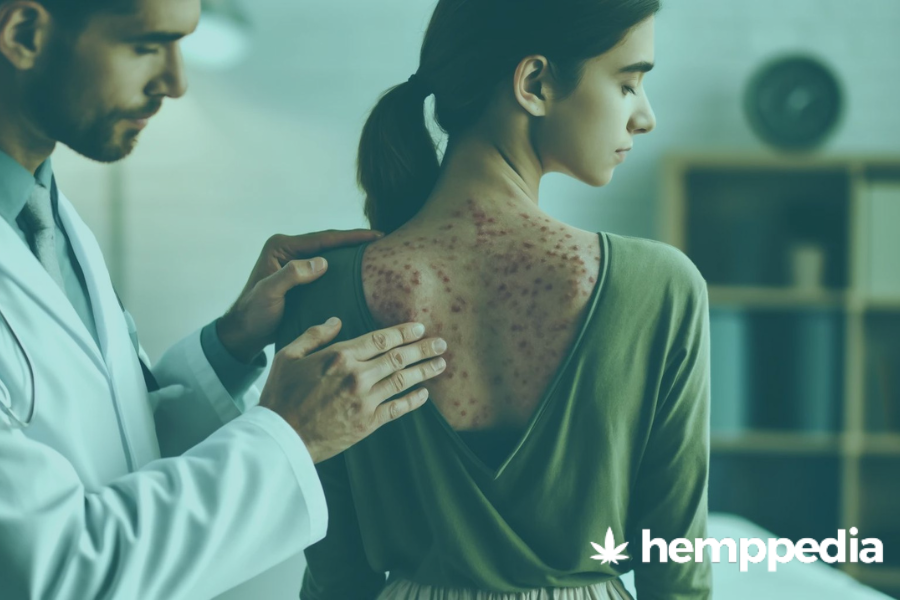Introduction
Shingles or Herpes Zoster (HZ) is a painful rash that develops in the body.
In the United States alone, one million people each year are prone to develop shingles says the CDC (Centers for Disease Control and Prevention).
If one in every three people are attacked by this condition, it is definitely a distressing number.
You might think that shingles are associated with a dermatological condition. Although it expresses itself as a painful red rash in various parts of the body, let us recall that in the article cbd oil for back pain we discussed in detail the different types of pain. And we understood that Shingles is a typical example of neuropathic pain that causes burning, shooting pain, nerve pain, accompanied by tingling or itching.
Having said that, the complexity of neuropathic pain in diagnosis and treatment is undeniable. Therefore to simplify the subject, this post aims to approach this inquiry keeping in mind the most common questions that one could possibly have in mind about shingles.
Of course, we would discuss to what extent cbd plays a role in such conditions and the applicability of cbd oil in providing relief from shingles pain.
Because studies have shown that the prevailing treatment options for neuropathic pain benefit only a few people as it often comes with more side effects that overshadow the benefits of the medication. This is the reason, there is a pressing need to probe into other options that could provide a better cure without contradictory after effects.
At this point, CBD oil or CBD-based products have been gaining strong advocacy from patient groups who have practically experienced relief and improvement from chronic pain.
Hence, affected patients and susceptible populations could benefit from this compilation as a reference guide to take precautionary measures and possible approaches for the cure. Let us explore further.
What is shingles or Herpes Zoster (HZ)?
Shingles is basically a viral infection that leads to a painful rash on the skin.
The NIH ( National Institute of Neurological Disorders and stroke) defines shingles also called herpes zoster as an outbreak of rash or blisters on the skin that is caused by the varicella-zoster virus.
Do I have to get alarmed with the word ‘Herpes’?
The word herpes does trigger a chill. But herpes zoster is different from herpes simplex virus. The latter is the one that causes genital herpes or sexually transmitted diseases. (STD)
Herpes zoster and herpes simplex although look similar in terms of the lesions but the zoster virus presents itself on the skin in different parts of the body. And the underlying cause is the varicella virus.
On the other hand, the herpes simplex virus causes cold sores and multiple blisters in the mouth, or genitals.
Hence there is no reason to get alarmed with the term herpes.
Is shingles the same as Chickenpox?
No, they are not the same. Chickenpox is the initial infection and shingles is a post chicken pox condition that usually reactivates years later. People who have been already affected by chickenpox, are more susceptible to shingles.
In both conditions, varicella-zoster is the virus that causes the disease.
For example, once a person gets infected with the varicella-zoster virus, he suffers from chickenpox, with severe blisters that present themselves throughout the body and could last for a couple of weeks. Once the patient is out of the condition, the virus remains dormant in the body forever. In a shingles outbreak, the same virus gets activated once again after several years and expresses itself as shingles rash in one part of the body.
According to the AAD (American Academy of Dermatology Association), the virus moves from the skin to the nerves once the chickenpox is cleared and in situations when it travels back to the skin, there is a shingles outbreak.
Chickenpox and shingles symptoms are different. Although both are skin infections. Let us understand more.
How do I know if I have shingles or just an allergic skin rash?
Sometimes, shingles could be mistaken for other skin allergies or conditions like eczema or psoriasis. Therefore looking at certain symptoms you can make sure that you have been affected and seek necessary medical intervention.
Shingles symptoms include:
- Blisters that appears as a stripe on the left or right side of the torso
- Pain, itching, and tingling sensations begin to develop on one side of the body
- Fluid-filled blisters that appear in clusters and are red that develop in a stripe pattern
- It may also appear on the face, forehead, or sometimes around the eyes. In such a case, consulting an ophthalmologist is very important, because a severe rash around the eye could affect vision.
- People who have a weak immune system might develop a more widespread rash
- Fever, headache, fatigue, sensitivity to touch, sensitivity to pain, and stomach upset are some of the other associated symptoms.
Is it contagious?
Generally, people affected with shingles cannot spread the same to others. As a rule of thumb, whenever a person is affected by a viral infection they often stay isolated and follow hygiene in order not to spread to others.
However, according to the CDC, people with shingles cannot spread the virus before the rash or after the rash has cleared. On the contrary, people with chickenpox could easily transmit the varicella-zoster virus to another person.
At the same time, it is important to avoid contact with the fluid from blisters that could possibly pass on the varicella-zoster virus to people who have never had chickenpox.
Other side effects associated with shingles
- As mentioned above, the possibility of vision loss if shingles affect your eye. If rashes appear in or around the eyes, side-effects may be adverse.
- For most patients, the symptoms reduce in two to four weeks, but in some cases, the shingles pain persists or tends to aggravate leading to a chronic pain condition that is called Postherpetic neuralgia (PHN), a common complication from shingles.
Moreover, clinical trials report that postherpetic neuralgia is common in elderly persons who are affected by sleep disorders, chronic fatigue, anxiety, and severe depression.
How to treat shingles?
- Antiviral medications such as acyclovir, valacyclovir, and famciclovir are prescribed by dermatologists to shorten the severity period. If you notice symptoms of shingles in your body, it is highly recommended that you seek medical advice promptly.
- traditional painkillers that are sold across the counter, prescription drugs
- Self-care includes: cleaning the blisters with a cold compress, applying calamine lotion, oatmeal bath, covering the affected area with sterile bandages, wearing loose clothing. These self-care methods may help in providing temporary relief from sensitivity to pain or the severity of the painful red rash.
- A 2018 study1 analyzed the safety and efficacy of cannabis-based medicines for chronic neuropathic pain in adults. And postherpetic Neuralgia and shingles are typical neuropathic pain conditions. One of the inferences from the study is that cannabis medications may increase the number of people achieving 50% or greater pain relief compared with placebo.
Besides traditional treatments, is there any other possibility to treat shingles? Let us discuss further.
Role of CBD in treating shingles pain?
After the US FDA approved cannabidiol (CBD) as Epidiolex to treat epilepsy in children and adults, the societal acknowledgment of cannabis-based products and cbd oil for putative use has been steadily increasing.
In the same lines, the anti-inflammatory and immunosuppressive potential of CBD or CBD-based products is being researched. Similarly, the ability of cbd to be applied in treating viral infection-related situations is gaining attention, although available conclusive studies are limited.
The endocannabinoid system is an essential part of the human body. It consists of numerous cell receptors that not only initiate physiological processes but also monitor essential body functions. Such as mood, stress, immune system, pain regulation, and the neurological system.
Research findings from the National Institute on Drug Abuse & Stony Brook University confirmed the involvement of the endocannabinoid system involvement in physiological processes that are essential in treating pain.
The latest study2 reports that the use of cbd for conditions associated with viral infections shows effectiveness in preclinical studies but lacks clinical evidence.
Inferences from yet another 2020 study3 reports that the available data is supportive to demonstrate that cbd can help in immune suppression, activation, and control of various immune cell types.
A 2010 study4 points out that conventional therapies fail to reduce the burning nerve pain in postherpetic neuralgia conditions. Therefore, the clinical trial concluded that topical therapy is more effective and well-tolerated as an adjuvant therapy option in conditions of chronic pain. (post shingles) Because the nerve fibers that transmit the pain are expressed through cannabinoid receptors in the endocannabinoid system which in turn exert a modulatory role in nociceptive symptoms.
To sum up, the role of cbd in providing pain relief and pain management through the endocannabinoid receptors has been extensively discussed in several hemppedia articles. Moreover, the cb2 receptors are located primarily on inflammatory and immune-related cells, and hence their reaction to the inflammatory response is well defined.
How to use cbd oil for shingles pain?
Anecdotal pieces of evidence from studies have shown that taking cbd orally or topically applying cbd oil for shingles may help in pain conditions. Moreover, the use of cbd oil in pain management is generally well-tolerated in human and animal models. As a golden rule of thumb, while taking cbd keep in mind dosage. Dosage is key. At the same time, depending on the severity of your condition, especially if you have symptoms indicating shingles, seeking immediate medical consultation and advice is mandatory.
From a 2017 study5 we can understand that CBD is often used as an adjunct therapy. This is because cbd has a better side effect profile compared to other drugs. That is why patients’ compliance and adapting to treatments is easy.
Therefore the topical application of cbd oil could provide localized relief and oral administration of cbd oil could provide overall therapeutic relief including suppressing pain and improved sleep.
Recommended reading: cbd oil for chronic pain
Who is at risk for developing shingles?
- Since 2008, older adults have been showing rising trends in developing shingles. That is people who are 50 years and above are more prone. Although children under the age of 10 and middle-aged adults are also susceptible.
- Incidence increases with age, that is for adults over 60 years.
- People with impaired immunity are at risk.
Is there a relevance to herpes zoster and rheumatic diseases? Does cbd have a role?
Rheumatic disease is a condition that usually affects joints, tendons, ligaments, bones, and muscles. And arthritis is a disorder that affects the joints.
And the relevance to the rheumatic diseases and shingles virus is chronic pain.
A 2014 study6 records that the frequency of HZ in the general population has increased in rheumatic arthritis in recent years. And the severity of rheumatic arthritis is associated with the development of HZ.
A 2020 study7 asserts that cannabinoids have an inflammatory modulating quality that could have a therapeutic effect in conditions such as chronic pain and rheumatic diseases.
We can sum up that from the available clinical studies and pieces of evidence from internet research, cannabinoids do have a role in pain and in pain management. However specific reference to the applicability of different cbd products or cbd oil for shingles needs more attention and study.
Preventing Shingles
Vaccines help prevent shingles or at least in reducing their severity.CDC recommends the recombinant zoster vaccine, Shingrix® and Zostavax in two doses, given in 2 to 6 months apart.
Studies say that there is no cure for the shingles virus and the vaccines that are recommended or mandated are preventive therapy only and not a treatment for shingles or postherpetic neuralgia.
It is noteworthy to mention a reference from a 2020 study8 that highlights the need for a warranting review of the current vaccine recommendations. Because the incidence of HZ continues to increase.
Conclusively, cannabis enthusiasts are eagerly awaiting evidence from clinical studies. So that they could access supportive reports to prove the applicability and efficacy of cbd and cbd based products such as CBD oil, CBD creams, CBD tinctures, CBD vapes, CBD capsules, CBD edibles, etc to treat various diseases and conditions.
What does the research say about the future of the disease?
A 2010 study9 recommends a prompt intervention to address the growing numbers in the elderly population affected by HZ and there is a mounting economic burden due to the disease.
References
- Mücke M, Phillips T, Radbruch L, Petzke F, Häuser W. Cannabis-based medicines for chronic neuropathic pain in adults. Cochrane Database Syst Rev. 2018;3(3):CD012182. Published 2018 Mar 7. doi:10.1002/14651858.CD012182.pub2 [↩]
- Alex Mabou Tagne, Barbara Pacchetti, Mikael Sodergren, Marco Cosentino, and Franca Marino.Cannabis and Cannabinoid Research.Jun 2020.121-131.http://doi.org/10.1089/can.2019.0060 [↩]
- Nichols JM, Kaplan BLF. Immune Responses Regulated by Cannabidiol. Cannabis Cannabinoid Res. 2020;5(1):12-31. Published 2020 Feb 27. doi:10.1089/can.2018.0073 [↩]
- Phan NQ, Siepmann D, Gralow I, Ständer S. Adjuvant topical therapy with a cannabinoid receptor agonist in facial postherpetic neuralgia. J Dtsch Dermatol Ges. 2010;8(2):88-91. doi:10.1111/j.1610-0387.2009.07213.x [↩]
- Iffland K, Grotenhermen F. An Update on Safety and Side Effects of Cannabidiol: A Review of Clinical Data and Relevant Animal Studies. Cannabis Cannabinoid Res. 2017;2(1):139-154. Published 2017 Jun 1. doi:10.1089/can.2016.0034 [↩]
- Veetil BM, Myasoedova E, Matteson EL, Gabriel SE, Green AB, Crowson CS. Incidence and time trends of herpes zoster in rheumatoid arthritis: a population-based cohort study. Arthritis Care Res (Hoboken). 2013;65(6):854-861. doi:10.1002/acr.21928 [↩]
- Gonen T, Amital H. Cannabis and Cannabinoids in the Treatment of Rheumatic Diseases. Rambam Maimonides Med J. 2020;11(1):e0007. Published 2020 Jan 30. doi:10.5041/RMMJ.10389 [↩]
- Thompson RR, Kong CL, Porco TC, Kim E, Ebert CD, Acharya NR. Herpes Zoster and Post-Herpetic Neuralgia: Changing Incidence Rates from 1994 to 2018 in the United States [published online ahead of print, 2020 Aug 23]. Clin Infect Dis. 2020;ciaa1185. doi:10.1093/cid/ciaa1185 [↩]
- Gialloreti LE, Merito M, Pezzotti P, et al. Epidemiology and economic burden of herpes zoster and post-herpetic neuralgia in Italy: a retrospective, population-based study. BMC Infect Dis. 2010;10:230. Published 2010 Aug 3. doi:10.1186/1471-2334-10-230 [↩]





